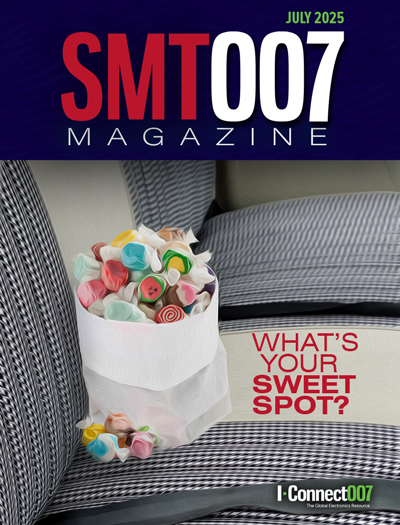-

- News
- Books
Featured Books
- smt007 Magazine
Latest Issues
Current Issue
Spotlight on India
We invite you on a virtual tour of India’s thriving ecosystem, guided by the Global Electronics Association’s India office staff, who share their insights into the region’s growth and opportunities.

Supply Chain Strategies
A successful brand is built on strong customer relationships—anchored by a well-orchestrated supply chain at its core. This month, we look at how managing your supply chain directly influences customer perception.

What's Your Sweet Spot?
Are you in a niche that’s growing or shrinking? Is it time to reassess and refocus? We spotlight companies thriving by redefining or reinforcing their niche. What are their insights?
- Articles
- Columns
- Links
- Media kit
||| MENU - smt007 Magazine
Acceptance Testing Of Low-Ag Reflow Solder Alloys (Part 1)
August 12, 2015 | K. Troxel, A. Allen, E.E. Benedetto, R. Joshi, Hewlett-Packard Co.Estimated reading time: 9 minutes
There were two manufacturing design of experiments (DoEs) as part of each SMT alloy evaluation. Both consisted of building boards with a low-Ag SMT alloy and a SAC305 control at defined process parameters (with multiple peak reflow temperatures and times above liquidus, TAL). Small test boards were selected for each DoE so that they could be processed with very small temperature deltas across the boards, eliminating this variable. This gave confidence in the DoE results on whether an alloy was able to form acceptable solder joints at each specified temperature and TAL.
BGA solder joints were evaluated for two different sizes of BGA component (see test board in Figure 1). In this DoE, three parameters were evaluated: BGA solder joint formation (in cross-section) per IPC-A-610, intermetallic compound (IMC) thickness, and Cu dissolution.
Figure 1: BGA Manufacturing DoE Test Board. Boxed locations (U4, U9, PCB pad for U11) are thermocouple locations.
The second DoE evaluated numerous leaded components (see test board in Figure 2). In this DoE, leaded solder joint formation per IPC-A-610 was assessed for the low-Ag alloy.
For the low-Ag alloy to be feasible for use in general PCA assembly, it must not dissolve excessive amounts of Cu, it must not form very thick IMCs that might be prone to fracture under mechanical stresses, and it must form acceptable solder joints within the OEM’s PCA processing window. The first two requirements (Cu dissolution, IMC thickness) were evaluated at a single process condition, 250 °C and 120 seconds TAL, processed three times. This process condition was selected as representative of the PCA process conditions of a complex product board that is reworked twice. This would be the worst-case conditions, from an IMC growth and Cu dissolution standpoint. The last requirement, forming acceptable solder joints, was the basis for the wide range of TALs and peak reflow temperatures in both DoEs; ranges beyond what would be considered a normal process window, but necessary to determine the processing cliffs where the low-Ag alloy fails to form acceptable solder joints. An example of the manufacturing DoE process conditions is in Table 2.
Figure 2: Leaded component DoE test board. Numbered components are to be populated (1-5 to be cross-sectioned). Ref: SMTA Saber
Of the 15 process conditions assembled, a subset (green boxes) was selected for cross-sectioning and inspection to determine BGA solder joint formation per IPC-A-610, IMC thickness, and Cu dissolution. If questions arose on the data, additional process conditions (yellow boxes) may be evaluated.
Wetting balance was evaluated for the low-Ag alloys (compared to SAC305) by following industry test method J-STD-003. A sample size of 10 coupons, per alloy, was used. A standard activated rosin flux #2 for Pb-free alloys was specified to keep different vendor test results consistent. The test boards were preconditioned for 8 hours at 72 °C/85% RH, followed by 1 hour at 105 °C. For the wetting balance test, the coupons were immersed in molten solder, 45° incident to the solder pot, to a depth of 0.4 mm at 2 mm/second.
Table 2: Example process conditions for manufacturing DoE.
Reliability Tests
The reliability tests included accelerated thermal cycling (ATC) and mechanical shock testing. Both these tests used BGAs processed at a single process condition that formed acceptable solder joints (per IPC-A-610). The BGA Manufacturing DoE Test Board (see Figure 1) was used for both reliability tests, populated with the eight smaller CABGA-192 components.
Mechanical shock testing was performed per JEDEC standard JESD22-B111 (test condition B, 1500 G, 0.5 ms duration, half-sine pulse). The controls were Sn-37Pb and SAC405. For all alloys tested, the solder ball and SMT paste were the same alloy (no mixing of solder compositions was chosen, since a low-Ag alloy ball with SAC305 paste should have intermediate performance between a low-Ag alloy and a SAC305 solder joint). For each alloy, the mechanical shock performance was evaluated on Cu OSP and electrolytic Ni/Au PCB surface finishes. Resistance was monitored in-situ, Weibull failure plots generated, and failure modes verified with selective failure analysis after test completion.
ATC testing was executed per IPC-9701 (test condition 1) to 6000 thermal cycles. The controls were Sn-37Pb and SAC305. The test board had a Cu OSP surface finish. For all alloys tested, the solder ball and SMT paste were the same alloy, for the same reasons discussed above for mechanical shock testing. Resistance was monitored in-situ, Weibull failure plots generated, and failure modes verified with selective failure analysis after test completion.
Bulk Solder Material Properties
Bulk solder material properties evaluated included melting behavior (DSC or DTA curves per NIST SP 960-15), stress-strain curves (with a specified sample geometry per ASTM E8-04), elastic modulus (per ASTM 1875-00), coefficient of thermal expansion (per ASTM E831-06), density, hardness (per ASTM E92-82), electrical conductivity (per ASTM B193-02), and thermal conductivity.
In Part 2 of this two-part article series, the authors will discuss their test results as well as observed defects.
Editor's Note: This paper has been published in the technical proceedings of IPC APEX EXPO.
Page 2 of 2Testimonial
"The I-Connect007 team is outstanding—kind, responsive, and a true marketing partner. Their design team created fresh, eye-catching ads, and their editorial support polished our content to let our brand shine. Thank you all! "
Sweeney Ng - CEE PCBSuggested Items
Koh Young, Fuji, and Kurtz ERSA Drive Smart Manufacturing Solutions for EV and Automotive Electronics at Kunshan, China Technical Seminar
09/11/2025 | Koh YoungKoh Young Technology, the global leader in True 3D measurement-based inspection solutions, partnered with Fuji Corporation and Kurtz ERSA to host an exclusive technical seminar for leading automotive manufacturers in East China. Held on September 4 at Fuji’s factory in Kunshan, the event gathered participants representing over 35 companies.
MacDermid Alpha Presents at SMTA New Delhi, Bangalore Chapter, on Flux–OSP Interaction
09/09/2025 | MacDermid Alpha Electronics SolutionsMacDermid Alpha contributes technical insights on OSP solderability at the Bangalore Chapter, SMTA reinforcing commitment to knowledge-sharing and industry collaboration.
Electra’s ElectraJet EMJ110 Inkjet Soldermask Now in Black & Blue at Sunrise Electronics
09/08/2025 | Electra Polymers LtdFollowing the successful deployment of Electra’s Green EMJ110 Inkjet Soldermask on KLA’s Orbotech Neos™ platform at Sunrise Electronics in Elk Grove Village, Illinois, production has now moved beyond green.
Absolute EMS: The Science of the Perfect Solder Joint
09/05/2025 | Absolute EMS, Inc.Absolute EMS, Inc., a six-time award-winning provider of fast turnaround, turnkey contract electronic manufacturing services (EMS), is drawing attention to the critical role of 3D Solder Paste Inspection (SPI) in ensuring the reliability of both FLEX and rigid printed circuit board assemblies (PCBAs).
Indium Corporation to Highlight High-Reliability Solder Solutions at SMTA Guadalajara Expo
09/04/2025 | Indium CorporationIndium Corporation, a leading materials refiner, smelter, manufacturer, and supplier to the global electronics, semiconductor, thin-film, and thermal management markets, will feature a range of innovative, high-reliability solder products for printed circuit board assembly (PCBA) at the SMTA Guadalajara Expo and Tech Forum, to be held September 17-18 in Guadalajara, Mexico.


